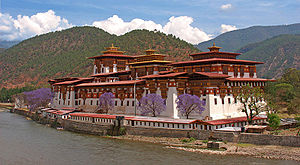
Punakha
Encyclopedia

Punakha District
Punakha District is one of the 20 dzongkhags comprising Bhutan. It is bordered by Thimphu, Gasa, and Wangdue Phodrang Districts...
, one of the 20 districts of Bhutan
Bhutan
Bhutan , officially the Kingdom of Bhutan, is a landlocked state in South Asia, located at the eastern end of the Himalayas and bordered to the south, east and west by the Republic of India and to the north by the People's Republic of China...
. Punakha was the capital of Bhutan and the seat of government until 1955, when the capital was moved to Thimphu
Thimphu
Thimphu also spelt Thimpu, is the capital and largest city of Bhutan. It is situated in the western central part of Bhutan and the surrounding valley is one of Bhutan's dzongkhags, the Thimphu District. The city became the capital of Bhutan in 1961...
. It is about 72 km away from Thimphu and it takes about 3 hours by car from the capital Thimphu. Unlike Thimphu it is quite warm in winter and hot in summer. It is located at an elevation of 1,200 metres above sea level and rice is grown as the main crop along the river valleys of two main rivers of Bhutan, the Pho Chu and Mo Chu. Dzongkha is widely spoken in this district.
Pungthang Dewachen Gi Phodrang

Pungthang Dewachen Phodrang (Palace of Great Happiness) or Punakha Dzong was constructed by Tuebi Zaow Balip under the great command of Zhabdrung Ngawang Namgyal in 1637 and believed to have been completed in two years of time period. It is also the country's most beautiful Dzong.It is the winter residence of Bhutan's Central Monastic Body
Dratshang Lhentshog
The Dratshang Lhentshog is the Commission for the Monastic Affairs of Bhutan. Under the 2008 Constitution, it is the bureaucracy that oversees the Drukpa Kagyu sect that is the state religion of Bhutan...
led by HH the Je Khenpo
Je Khenpo
The Je Khenpo , formerly called the Dharma Raj by orientalists, is the title given to the senior religious hierarch of Bhutan. His primary duty is to lead the Dratshang Lhentshog of Bhutan, which oversees the Central Monastic Body, and to arbitrate on matters of doctrine, assisted by lopons...
. The Dzong houses the most sacred relics of the Southern Drukpa Kagyu school including the Rangjung Kasarpani, and the sacred remains of Zhabdrung Ngawang Namgyal and Terton Padma Lingpa
Pema Lingpa
Pema Lingpa or Padma Lingpa was a famous saint and siddha of the Nyingma school of Tibetan Buddhism. He was a preeminent terton , and is considered to be foremost of the Five Terton Kings...
.
In 1907, Punakha Dzong was the site of the coronation of Ugyen Wangchuck
Ugyen Wangchuck
Gongsa Ugyen Wangchuck was the first King of Bhutan from 1907 to 1926.He was born in 1862 to Jigme Namgyal, penlop of Trongsa and Ashi Pema Choki. He succeeded his father as Penlop of Trongsa...
as the first King of Bhutan. Three years later, a treaty was signed at Punankha
Treaty of Punakha
The Treaty of Punakha was an agreement signed on January 8, 1910, at Punakha Dzong between the recently consolidated Kingdom of Bhutan and British India. The Treaty of Punakha is not a stand-alone document, but represents a modification of the Treaty of Sinchula of 1865, the prior working agreement...
whereby the British agreed not to interfere in Bhutanese internal affairs and Bhutan allowed Britain to direct its foreign affairs.
In 1987, the dzong was partially destroyed by fire.
Due to its location at the confluence of the Pho Chhu and Mo Chhu
Mo Chhu
Mo Chhu is a major river in Bhutan. The word "Chhu" means "river" or "water" in Dzongkha, the official national language in Bhutan. The river rises in Gasa Dzongkhag near the border between Bhutan and Tibet. From there, the Mo Chhu flows generally southward to Punakha in central Bhutan, where it...
rivers in the Punakha-Wangdue valley, the dzong is vulnerable to flash flooding caused by glacier lakes (GLOF). According to a recent report, flash flood damage to Punakha Dzong occurred in 1957, 1960 and 1994. Currently (March 2010) work is in progress to protect the dzong from future flood damage by deepening the river channels and raising the embankments using four large steam shovels.
A covered wooden cantilever bridge
Cantilever bridge
A cantilever bridge is a bridge built using cantilevers, structures that project horizontally into space, supported on only one end. For small footbridges, the cantilevers may be simple beams; however, large cantilever bridges designed to handle road or rail traffic use trusses built from...
crossing the Mo Chhu river was built together with the Dzong in the 17th century. This bridge was washed away by a flash flood in 1957 or 1958. In 2006 work started on a new covered wooden cantilever bridge of traditional construction with a free span of 55 meters which was completed in 2008 with the help from the Germans.

